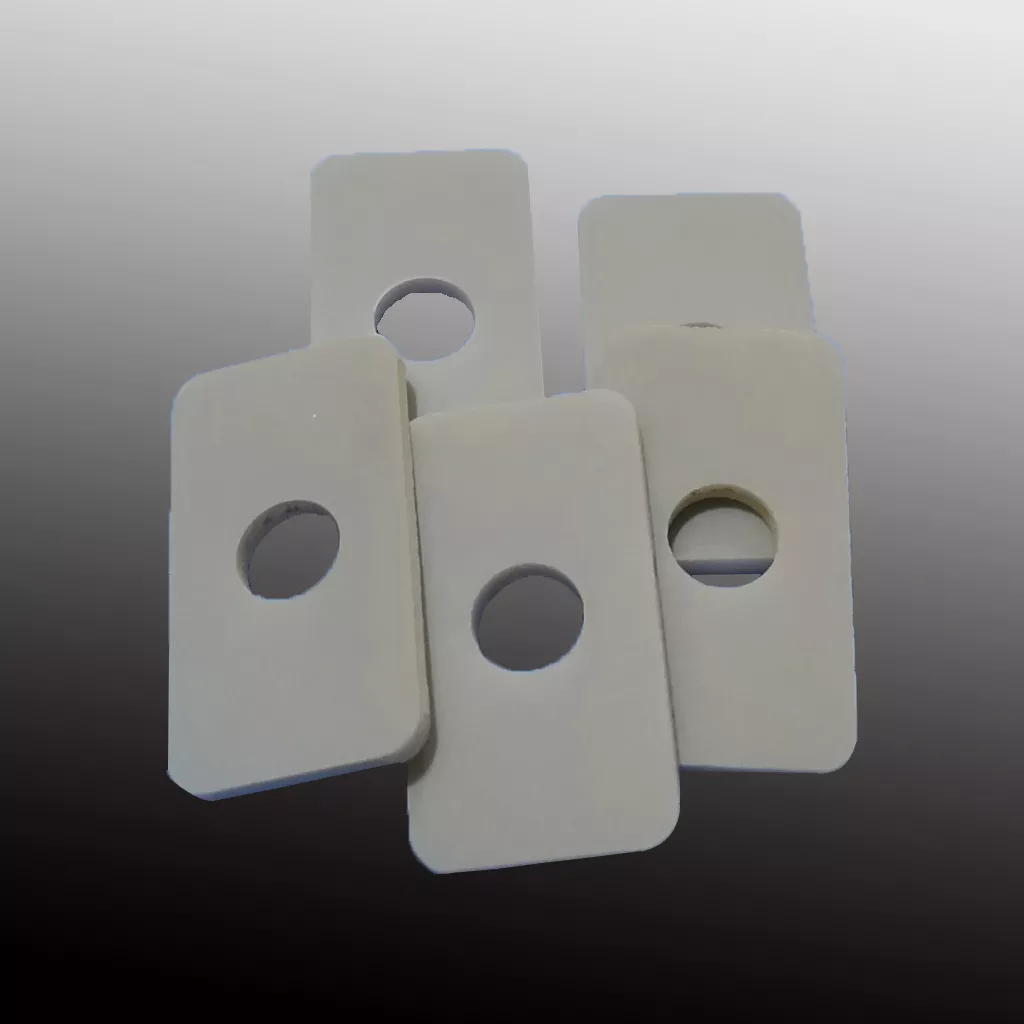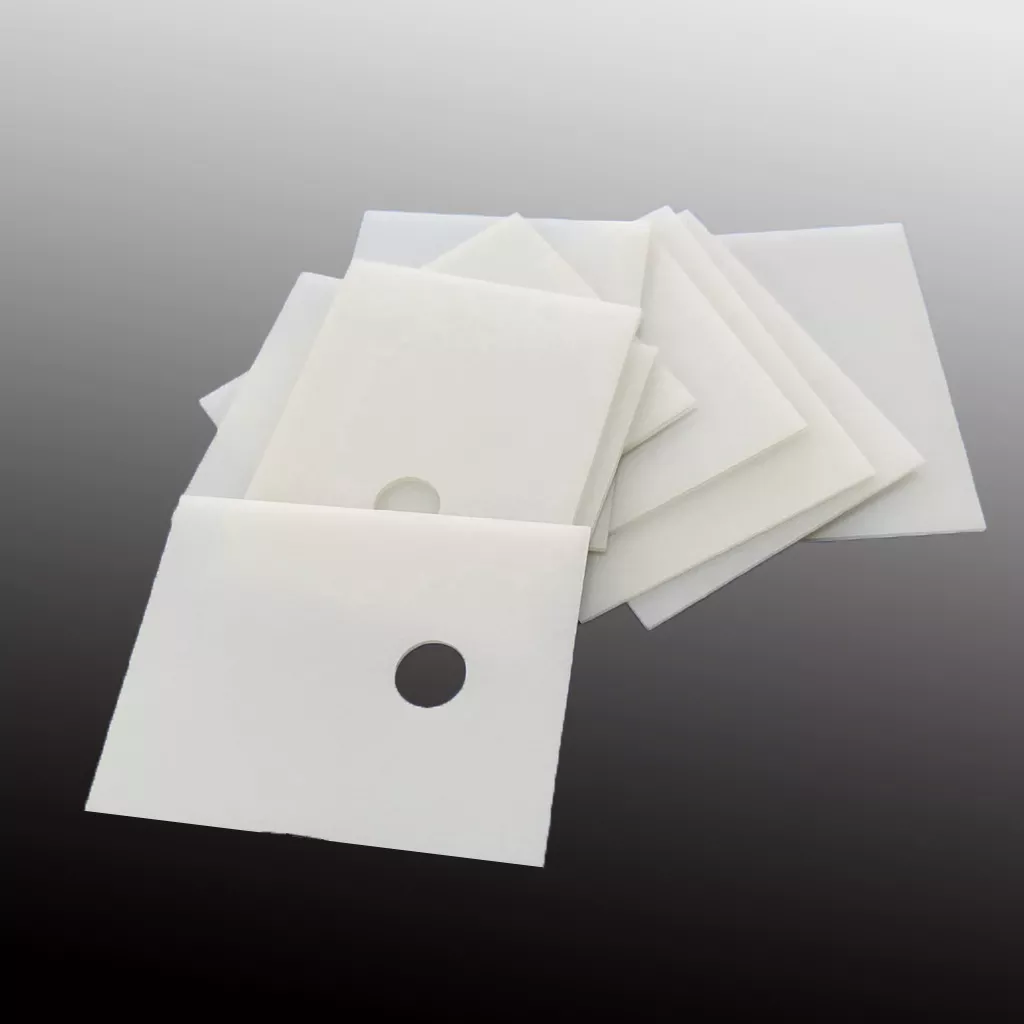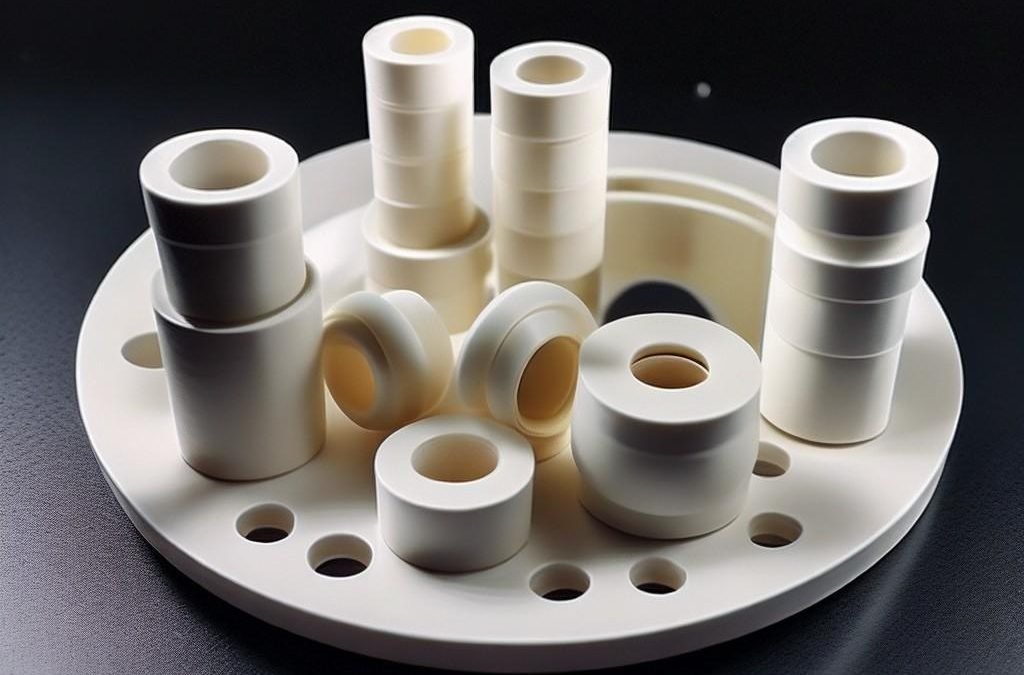Industrial ceramic parts have good thermal conductivity, insulation, high temperature resistance, wear resistance, corrosion resistance, various shapes, and are suitable for the use conditions of various equipment parts and components. Common materials for industrial ceramics are alumina, zirconia, and aluminum nitride. What are the differences between these materials? What should you choose when using it?
Aluminum Nitride Ceramics
Aluminum nitride ceramic is a ceramic product whose main component is aluminum nitride.
The chemical composition of aluminum nitride is aluminum – 65.81%, nitrogen – 34.19%, with a specific gravity of 3.261g/cm³. It is usually white or off-white in color, and is colorless and transparent in the single crystal state.
Advantages of aluminum nitride:
Under normal pressure, the sublimation decomposition temperature of aluminum nitride is 2450°C, making it a highly heat-resistant material. The thermal expansion coefficient is 4.0-6.0)X10-6/℃. The thermal conductivity of polycrystalline aluminum nitride is 5-8 times higher than that of aluminum oxide, so it is equivalent to aluminum oxide. Aluminum nitride is more resistant to thermal shock and can withstand high temperatures of 2200°C. Aluminum nitride also has excellent corrosion resistance and is not corroded by liquid aluminum and other molten metals.
Disadvantages of aluminum nitride ceramics:
High cost, aluminum nitride powder is easy to hydrolyze, energy consumption is high in the production process of aluminum nitride powder products, preparation is difficult, impurities may be incorporated, and safety issues arise during use.


Alumina Ceramic
Alumina ceramic is a ceramic product based on alumina.
Alumina content can be divided into various specifications such as 60%, 70%, 85%, 95%, 96%, 97%, 99%, 99.7%, etc. High-purity alumina ceramics refer to alumina content ≥ 99.9%, sintering temperature It can reach 1650℃-1990℃. Common forms are crucibles, sodium lamp tubes, circuit boards, and high-frequency insulating materials. Those with alumina content less than 99.9% are usually ordinary alumina ceramic products, usually in the form of high-temperature crucibles, high-temperature furnace lining rollers, special wear-resistant parts, seals, water valves, etc.
Advantages of alumina ceramics:
There are various and complete molding processes, such as dry pressing molding, slip molding, isostatic molding, injection molding, tape molding, extrusion molding, etc. It has good insulation performance, excellent wear resistance, light weight to reduce equipment load, lower cost and more cost-effective compared to aluminum nitride ceramics. It also has corrosion resistance and good thermal conductivity.
Disadvantages of alumina ceramics:
High hardness, brittleness, and brittleness. The weight of the ceramic parts should be considered when choosing.
Zirconia ceramic
Zirconia ceramics usually appear white, but may appear yellow or gray when mixed with impurities.
Advantages of zirconia ceramics:
Light weight, reducing the load on mechanical equipment, easy to process, good elasticity and flexibility, not easy to wrinkle, excellent colorability, and usable in all seasons.
Disadvantages of zirconia ceramics:
Not wear-resistant, not oil-resistant, easy to get dirty. When choosing zirconia ceramics, you need to consider the use environment factors.

Differences between alumina/zirconia/aluminum nitride ceramics
High temperature resistance:
Alumina ceramic: 1600-1700℃
Zirconia ceramic: ≤1100℃
Aluminum nitride ceramic: 2200℃
Thermal conductivity:
Alumina ceramic: 20W/m·k (20℃).
Zirconia ceramic: 2W/m·kAluminum nitride ceramics: 5-8 times that of alumina ceramics under the same environment
Cost:
Alumina ceramics: low cost
Zirconia ceramics: higher cost
Aluminum nitride ceramics: high cost
If you are interested in or need industrial alumina/zirconia/aluminum nitride ceramics, please contact us, China’s professional industrial ceramics supplier, we can customize the ceramic products you need according to drawings!
FAQ
Can you provide samples for me to test? How much does it cost?
We strive to provide ceramic samples that closely meet your requirements to the best of our abilities.
The samples are completely free, but you need to pay the freight.
For samples with unique shapes that require custom molds, we are open to discussing the mold cost in order to accommodate your specific needs.
We don’t know which material of ceramic we need, what should we do?
No worries! Please provide us with more details about your requirements, such as the intended use, desired properties, and any specific characteristics you're looking for.
With these information, our team can guide you in selecting the most suitable ceramic material for your needs.
We are concerned about the quality of the product we ordered.
We understand your worries and we maintain stringent quality control standards as following:
| Test Standard | Testing Dimension | Pass Rate | Standard Range |
|---|---|---|---|
| Appearance Inspection | Quantity and Severity of Defects | ≥ 97.3% | Determined by AQL standard |
| Dimensional Inspection | Size Accuracy and Consistency | ≥ 98.1% | Determined by ISO 9001 standard |
| Density Testing | Material Density | ≥ 97% | Determined by ASTM C20 standard |
| Hardness Testing | Surface Hardness | ≥ 98.2% | Determined by ISO 6508 standard |
| Flexural Strength Testing | Material Flexural Strength | ≥ 97.9% | Determined by ASTM C1161 standard |
| Thermal Shock Stability Testing | Material Thermal Shock Stability | ≥ 98.7% | Determined by ASTM C884 standard |
*Qualification standards higher than ISO standards
In addition to production line inspections, we also accept inspections from third-party organizations several times a month
While the occurrence of defects is extremely rare, it is an unavoidable possibility. If any quality issues arise, we take full responsibility and will expedite the reproduction process at cost price.
Our commitment is to ensure that our products meet the highest quality standards and promptly address any concerns to ensure customer satisfaction.
What is the processing accuracy of ceramics?
| Precision Requirement | Example | Unit |
|---|---|---|
| Surface Flatness | Ra ≤ 0.1 μm | μm |
| Dimensional Accuracy | Tolerance within tens of μm | μm |
| Aperture Precision | Diameter tolerance within a few hundred μm | μm |
| Surface Finish | Ra ≤ 0.2 μm | μm |
We maintain strict processing precision standards, ensuring that our products meet the majority of requirements using our standard manufacturing processes.
However, if you have a need for even higher precision products, please feel free to contact us.
We can discuss your specific requirements and explore customized solutions to meet your exacting standards.
What's your trade terms?
We prefer EXW, FOB and CIF as for terms.
T/T, West Union,30% deposit, 70% balance paid before delivery are greatly appreciated.
How long does your production take?
Q: What is the typical production lead time for Vhandy Ceramics?
A: The typical production lead time for Vhandy Ceramics is 15 to 20 days.
Q: Are there any situations where the actual delivery time may be longer?
A: Yes, in certain cases, such as shipping to distant countries, the actual delivery time may be extended beyond the standard range.
Q: What factors can contribute to longer delivery times?
A: Factors such as customs clearance procedures, transportation logistics, and international shipping arrangements can contribute to longer delivery times.
Q: How does Vhandy Ceramics handle potential delays?
A: Vhandy Ceramics strives to minimize potential delays and works closely with shipping partners to expedite the process whenever possible.
Q: Can I get an accurate delivery estimate for my order?
A: Yes, our customer service team can provide you with an estimated delivery time based on your specific order and location. They will also keep you informed throughout the production and shipping process.
Contact
*Your contact won’t be shared with 3rd party.
Shenyang Vhandy Technology Co., Ltd.
Room 401, D11 Block (Shenyang International Software Park), Shenyang, Liaoning, China
Phone/WeChat/WhatsApp
Tel
0086-24-31501218

